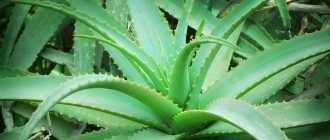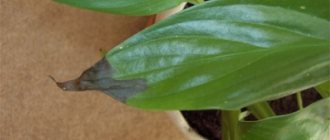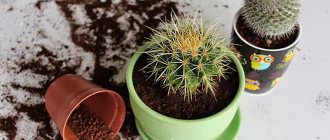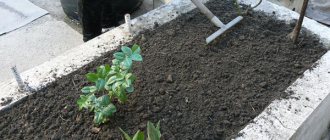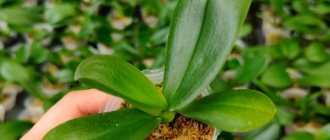General characteristics of soil for palm trees
If we talk about the characteristic features of the soil mixture, then when choosing a substrate it is worth paying attention to a number of aspects that are considered key:
- The soil should allow air to pass through and be loose.
- Acidity should be low, within 6.5.
What kind of soil and pot do you need for a palm tree?
Even a young palm tree needs nitrogen, but as a rule, substrates sold in flower shops contain this element in sufficient quantities. If necessary, you can feed the palm tree to speed up its growth. But the main thing here is not to overdo it.
The palm tree, as a plant that prefers warmth and sun, does not tolerate stagnant moisture; for this reason, it is better for the gardener to take care of the drainage system in advance.
If the soil is loose, allows moisture and air to pass through well, is low in acidity, and contains the necessary nutrients, then it can be safely used for planting.
Lighting Features
Any ornamental palm tree is a very capricious plant, which probably will not like ordinary soil, poor watering regime and weak fertilizer. Light was no exception. If you want the leaves to grow evenly, symmetrically and beautifully, then you need to develop a whole lighting system.
First of all, pay attention to the length of daylight hours - it should be 16 hours, no less, otherwise the leaves will turn a little yellow . If you illuminate the pot for 16-18 hours, the plant will be rich in color, healthy, and fast-growing. The second important point when growing an exotic bush is the periodic change in the angle of the rays. If you constantly light one side, the opposite side will be practically leafless. You need to change the lighting angle every 2 weeks (or rotate the pot itself with the other side). Only when you have a lush and symmetrical “crown”.
Leaves burn quickly, so you need to use fluorescent lamps and other lighting fixtures that emit no or very little heat. If it is not possible to use such devices, then we move the lighting device away from the tops. But remember that the light intensity in this case will be much less - increase the lamp power.
Composition of soil for plants
If you buy a ready-made substrate, then study the packaging; all the components of the mixture are indicated there; this information will be useful, as it will help you decide on your choice. Classic soil intended for planting palm trees should consist of the following components:
- high and low peat;
- coarse or river sand;
- mineral fertilizers;
- vermicompost;
- expanded clay drainage;
- dolomite flour.
Peat is turf soil that can be added gradually as plants grow and develop. And low-lying peat and leaf soil contain the remains of the root system of small plants.
By adding sand to the soil, you will be able to increase its useful characteristics - the mixture will easily allow air and water to pass through.
Agroperlite is also added to the soil composition. These are white granules that help improve breathability. Agroperlite increases air permeability, but adding sand helps to avoid caking and improve the quality characteristics of the earthen mixture.
Manufacturers can supplement the composition with a component such as hydrogel; its presence should not be confusing. Like vermiculite, hydrogel improves soil permeability and retains moisture.
Maintaining optimal temperature and humidity
The palm tree, like all exotic plants, loves very warm rooms. The average daily temperature should be at least +23 degrees. It will be even better if you can maintain +30C, but for a living space this is too much, suitable only for a specialized greenhouse or living area with separate heating. The tree does not like drafts, therefore, even at a relatively high temperature it can die.
Sudden changes in temperature are very dangerous for the plant. Cold air indoors in winter poses a great danger. If you open a window for a few minutes, the palm tree may die immediately if cold street air hits it. Low air humidity is especially bad for the health of exotic species. The leaves dry out, lose their natural color, and sometimes fall off. If you cannot maintain a constant humidity of 85-90%, you will have to spray the leaves regularly, preferably 2-3 times a day. For small rooms it is important to install a standalone air humidifier. Then it will be possible to leave the greenhouse for a long time without constant maintenance.
Additional soil components
The minerals contained in the soil help the plant to develop according to its natural programs.
As a supplement, there are mineral components that are part of the soil; they help optimize the plant growth process.
For example, vermicompost is another component of healthy soil. In nature, it is the food of earthworms, which enrich the soil and saturate it with oxygen.
The presence of drainage expanded clay in the composition will help to avoid excessive humidity, which is detrimental to palm trees.
To make the plant quickly grow, you can add leaf humus; it is often mixed with soil.
Rotten birch leaves will help saturate the soil with useful substances.
Soil for young palm trees
Depending on the age, palm trees have certain needs; to satisfy them, it is worth paying attention to the composition of the soil mixture.
The following universal soil is suitable for young palm trees:
- Wood and leaf soil are mixed in equal parts, maintaining a 1:1 ratio.
- High-moor peat and coarse sand are added to the resulting mixture.
- The entire soil can be divided into 3.5 parts: 2 of which are leaf and turf soil, 1 part is high-moor peat, and half or ½ is sand.
As needed, and this is usually twice a year, the plant is fed with fertilizers: during planting, before or a few days after. To enrich the soil during the active growth phase, which occurs in the spring-summer period.
Every year, the young plant is transplanted into a new container, choosing the pot that is needed for the palm tree and at the same time completely replacing the soil. This is ideal. But often there is no time for a transplant. In this case, it is worth completely replacing the top layer of soil. But be careful, because most palm trees have a weak root system; minor damage can lead to the death of the seedling.
Palm trees respond well to foliar fertilizers that are sprayed on the leaves; you can use them as an alternative. But they cannot fully replace soil products.
When and how should a transplant be done?
In order for a plant to develop normally, it needs to be provided with adequate access to nutrition. Unfortunately, the root system of the palm tree is limited to the walls of the pot, and the soil becomes depleted over time and cannot provide the required amount of vitamins and minerals.
You can use fertilizers, however, they are not always able to support normal plant growth. Therefore, it is necessary to carry out timely replanting, helping the palm tree to move into fresh soil to gain access to nutrients.
Frequency and timing
Immediately after purchasing a plant, you should not delay replanting. The longer the palm tree is in a cramped pot (and this is how they are sold), the less health and strength it has. Therefore, it is better to carry out the transplant procedure a few days after purchase. In this case, you need to try to completely remove the substrate that was in the store pot.
In fact, the frequency of replanting largely depends on the age of the palm tree.
- If you purchased a very young plant, then you need to replant it every year.
- When the tree is already quite mature, but up to 6 years old, then replanting should be done every two or three years.
- A large adult palm tree needs to be replanted once every 5 years, and annually simply replace the top layer and periodically feed the plant.
The best time for the procedure is the end of winter - the beginning of spring. It is at this moment that growth processes begin to start, and the palm tree simply needs nutrition. And in the autumn and winter, it is better not to touch the plant, since the palm tree is at rest and you can disturb deep sleep.
Preparatory work
Before replanting a flower at home, you need to perform a series of sequential actions, the result of which will be the successful movement of the plant.
Preparing the plant
- The first step is to prepare the plant. To do this, the palm tree is carefully removed from the old pot.
- Then you need to make a thorough inspection of the rhizome. If there are putrefactive elements, as well as other suspicious places, they need to be removed. Don't forget to disinfect the cut area with charcoal or garden varnish.
- Before cutting off the putrefactive element, be sure to disinfect the scissors or sharp knife with alcohol. This is important in order to protect the plant from infection.
How to choose the right pot?
- It is necessary to pay attention to the choice of pot. In this case, you need to focus not only on its attractive appearance, but also on its height. It is desirable that the pot be stable, because falls are destructive for the palm tree.
- Buy containers of large diameter and preferably light colors. They will prevent overheating of the roots in case of direct sunlight, and also, high walls will help protect the plant from external factors.
- Remember that with each new transplant, the size of the pot should increase by 3-4 cm in diameter. If we are talking about replanting a fairly large plant, then you need to choose a flowerpot that is about a third larger than the previous container.
- Do not forget that the pot must be equipped with special drainage holes, which are carefully located at the very bottom.
However, you should not purchase containers that are too spacious, since free space does not always have a positive effect on palm tree growth.
Soil selection
It is advisable to purchase a special substrate that has air and water permeability. It is advisable to purchase special soil for palm trees at garden stores.
The soil must be fertile and loose , so that the palm tree will actively grow. In this case, the soil should be slightly acidic or completely neutral.
If you have not found a special soil for palm trees, the composition of the soil for cacti is very similar to it.
Also, you can buy a universal substrate, add sand, peat, garden soil to it . The composition of this recipe is very simple. Two parts of purified garden soil are added to one part sand and one part humus.
If you take the substrate from your garden, then it must be disinfected. To do this, the soil is placed on a baking sheet and heated in the oven at a temperature of 100 degrees for half an hour. You can also steam it over a boiling water bath or pour it with a solution of potassium permanganate.
Drainage
A drainage system in a pot is necessary in order to get rid of excessive amounts of moisture that forms under the roots. The drainage system is lined with ordinary fine expanded clay, which is carefully laid on the bottom in one or two layers.
Methods and technology for carrying out the procedure in room conditions
Depending on the purpose of the actions performed, there are several methods of transplantation. Let's look at each of them.
Methods
The standard transplant method is simple:
- The plant is carefully removed from the pot.
- Gently support the soil ball on the roots.
- Inspect the plant and remove the infected area.
- Drainage is placed in the new container. It is advisable that its thickness does not exceed 4 cm.
- Carefully covered with soil.
- The plant is carefully placed in the very center of the pot, the roots spread out and fill the voids.
- Everything is covered from above with a new layer of soil.
- Using your hands, the soil is compacted.
- It is moistened with water.
- If necessary, add a couple more layers of soil after shrinkage.
Removal and inspection
Removal and inspection are mandatory procedures. If you do not act carefully, you can damage the root system, thereby dooming the plant to death.
In order to remove the palm tree, you need to turn it over and tap the bottom of the pot with your fingers. At the same time, hold the trunk tightly at the base and rotate the container around its axis. If it's tight, turn it over and tap again.
The plant is removed along with a lump of earth and placed on specially spread paper. Then comes the stage of inspecting the root system. Remove rhizomes affected by rot or disease using a strictly disinfected instrument.
Weak roots treated with scissors must be disinfected with a solution of potassium permanganate.
Urgent unscheduled transplantation
Unscheduled transplantation takes place in the autumn-winter period , when the plants are dormant. Therefore, special rules must be followed.
When preserving the roots
This is a resuscitation measure that is used in case of rotting of the roots of a false palm tree. But the algorithm of actions is somewhat different.
- The palm tree needs to be carefully removed from the pot.
- The roots are cleaned of old soil using a brush and hands.
- Without exception, all soft and rotting parts of the roots must be removed.
- The sections, and the entire root system, are treated with wood ash, and in its absence, with activated carbon.
- The palm tree is carefully planted in a pot with fresh soil already pre-laid out.
- You can water the plants only a few days after transplantation. This is done in order to avoid the development of rot.
Avoid direct sunlight and fertilizing for the next two months.
Rooting cuttings
Sometimes it is impossible to save the root system of a palm tree. It changes color, softens, and voids appear inside. In this case, you need to carefully disinfect the tools using cotton pads and cut off all healthy parts of the root system. They try to root them separately.
- The stem should also be carefully separated with a sharp knife, if possible.
- The cuttings are carefully dried on the table for several hours and treated with charcoal.
- Parts of the stems should be stuck in a horizontal position into wet sand. Several packs remain on the surface.
- After about 30 days, small shoots should appear, as well as something similar to roots.
- They are carefully separated and then transplanted into new pots.
Rooting of shoots
The palm tree very rarely reproduces by young shoots. However, there is one special method for rooting it.
You will need:
- water;
- sand;
- perlite;
- palm soil;
- vermiculite
You will have to purchase special stimulating preparations that will create the most optimal environment for the appearance of roots.
The shoot is transplanted into nutritious soil prepared for it with drainage. After which they are covered with a film and germinate until the root system and new leaves appear.
Transplanting rare species
If you have a rare type of palm tree growing at home, then the procedure is performed according to the standard method. However, here you need to pay attention to choosing the right soil and proper care.
The transplant procedure is performed every few years. If the type of palm tree is quite rare, you need to use the opinion of specialists for replanting.
It is recommended to move from one pot to another in the spring.
Land for mature palm trees (over 5 years old)
Older plants require specific soil that meets all their needs. The composition of soil for an adult palm tree includes the following components:
- mix clay-turf soil and deciduous soil in equal parts;
- add high-moor peat and rotted manure to the mixture;
- Sand and charcoal will help supplement the composition.
An adult palm tree needs to be replanted every 5 years.
A drainage layer of several centimeters is placed at the bottom of the pot. It could be expanded clay. The drainage can be from 3 to 6 cm thick, depending on the size of the pot.
An adult plant is replanted every 5 years, the top layer of soil is replaced every 3 years.
Choosing ready-made soil for palm trees
Let's consider several options for ready-made mixtures and study their characteristics:
| Garden of Wonders | The composition includes large river sand, mineral components, as well as high-moor peat. |
| Albin | The soil is incredibly popular among gardeners and meets all the necessary characteristics. |
| Flower happiness | The composition contains complex fertilizers, dolomite flour, peat soil and sand. |
It is believed that the soil sold in the store is not suitable for planting plants that are more than three years old. Then a small amount of substrate is added to the soil, the remaining components are formed independently.
Store-bought soil is ideal for planting seedlings.
Growing
This indoor plant can not only be purchased in the store, as it is easy to grow yourself. It is necessary to take a ripe fruit seed and place it vertically in a medium-sized ceramic pot.
The soil is wet sand and sawdust. After 4 months, a sprout appears. After this, the question arises: how to transplant a palm tree? It’s easy to do this step by step at home.
